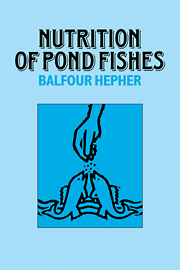Book contents
8 - Natural food and its estimation
Published online by Cambridge University Press: 06 August 2010
Summary
In spite of many gaps in the knowledge of nutrition of fish, as pointed out in the preceding chapters, sufficient information is now available to define, however crudely, the nutritional requirements of various fish species. In certain fish culture systems, such as flow or cage culture systems, where natural food has a minimal role, and most, if not all, food is provided by the farmer, this knowledge enables the formation of complete diets and the computation of feeding rates. Diets and rates will, no doubt, improve in time with the filling in of the gaps in our knowledge of fish nutrition. Formulation of complete diets removes one of the major factors limiting fish growth, and since the water current in these systems supplies the necessary oxygen and removes noxious metabolites, fish can be stocked at very high densities with a resulting high yield per unit area.
This is different in less intensive systems, where natural food plays some role in fish feeding. In extensive fish culture systems, where little or no supplementary feed is used, and fish depend largely on natural food, fish density must be adjusted to the amount of available natural food. If the density is too high, the amount of natural food per fish will not be enough to sustain the potential growth rate and the yield can be low. If on the other hand, the density is too low some of the food will not be utilized.
- Type
- Chapter
- Information
- Nutrition of Pond Fishes , pp. 255 - 278Publisher: Cambridge University PressPrint publication year: 1988



